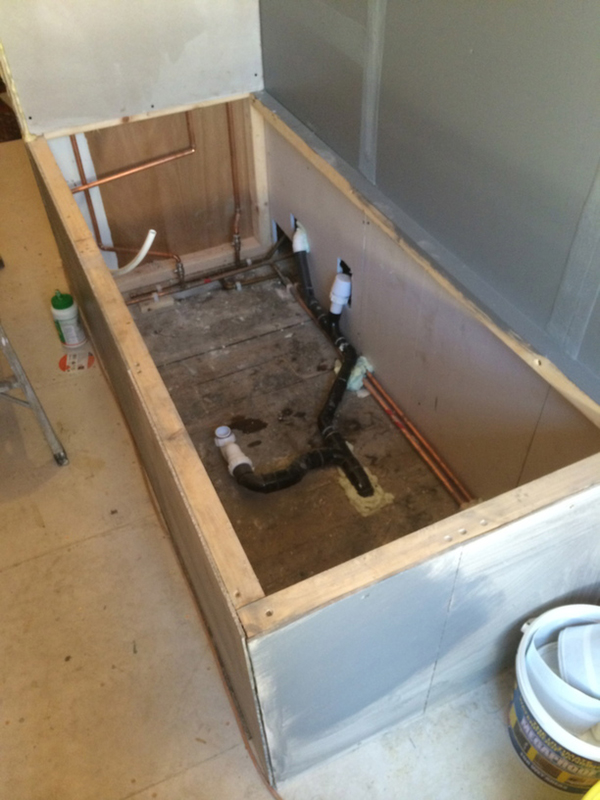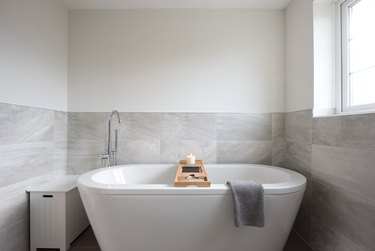Just How to Install a Bathtub in Your Bathroom
Just How to Install a Bathtub in Your Bathroom
Blog Article
Nearly everybody may have their own individual rationale in relation to How to Install a Bathtub Yourself.

Installing a bathtub isn't precisely brain surgery, but it does need strong plumbing, carpentry, as well as occasionally, tiling skills. Changing an old bath tub with a new one is likewise a reasonably difficult project. If the old bathtub is conveniently accessible, the project can move immediately; if you have to open a wall to eliminate the old tub and place the brand-new bathtub, the job is a lot harder. In either case, the job is within a residence handyman's skills, although you will need an assistant to vacate the old tub and also embeded in the new one. Make certain you have actually qualified yourself for the task and also are comfortable attempting it. As opposed to hiring a professional to take control of a halfway-completed job, it is much better to think about utilizing one prior to you start. Opportunities are you might require a specialist plumber to make tube links.
This write-up will certainly assist you mount a new tub in your shower room if you have actually currently acquired a new tub as well as don't require to transform the setup of your previous water supply pipes.
Your tools and also material checklist ought to make up the following:
Removing Old Taps
If you require to replace old taps with new ones as a part of your installation, then the first thing you should do is separate the water. After doing so, activate the faucets to drain any kind of water continuing to be in the system. The procedure of eliminating the existing faucets can be rather problematic due to the restricted accessibility that is usually the instance.
Utilize a basin wrench (crowsfoot spanner) or a tap tool to reverse the nut that connects the supply pipes to the faucets. Have a towel prepared for the staying water that will originate from the pipelines. When the supply pipes have been gotten rid of, make use of the exact same device to loosen the nut that holds the taps onto the bath/basin. You will certainly require to stop the solitary faucets from transforming during this process. Once the faucets have actually been gotten rid of, the holes in the bath/basin will certainly need to be cleansed of any type of old securing substance.
Prior to proceeding to fit the new faucets, compare the pipe connections on the old faucets to the brand-new taps. If the old faucets are longer than the brand-new taps, after that a shank adapter is needed for the brand-new faucets to fit.
Fitting New Taps
If the tails of the brand-new faucets are plastic, then you will require a plastic port to avoid damage to the thread. One end of the connector fits on the plastic tail of the faucet and also the various other end offers a connection to the existent supply pipelines.
If you require to fit a monobloc, then you will call for minimizing couplers, which connects the 10mm pipeline of the monobloc to the common 15mm supply pipeline.
Next, place the tap in the mounting opening in the bath/basin making sure that the washers remain in location between the faucet as well as the sink. Secure the faucet in place with the maker given backnut. When the tap is firmly in place, the supply pipelines can be linked to the tails of the taps. The faucets can either be connected by utilizing corrugated copper piping or with typical tap ports. The former kind ought to be linked to the tap finishes first, tightening up only by hand. The supply pipelines can later be connected to the other end. Tighten up both ends with a spanner after both ends have actually been linked.
Mounting the Tub
Making use of both wooden boards under its feet, put the bathtub in the needed position. The wood boards are useful in equally spreading the weight of the bath tub over the area of the boards rather than focusing all the weight onto 4 small points.
The next objective is to make certain that the bathtub is leveled all round. This can be achieved by inspecting the spirit level as well as adjusting the feet on the tub up until the level reviews level.
To install taps, fit the bottom of the outermost adaptable tap adapter to the appropriate supply pipe by making a compression sign up with; then do the exact same for the various other tap.
Turn on the water and inspect all joints and also brand-new pipework for leaks and tighten them if needed. Load the bath tub as well as likewise inspect the overflow electrical outlet and also the normal outlet for leaks.
Lastly, deal with the bathroom paneling as described in the producer's instruction manual. Tiling as well as securing around the bathtub should wait up until the tub has actually been made use of at the very least when as this will settle it into its final placement.
Preparing for the Installment
To start with, the sustaining structure provided with the bathroom needs to be fitted (if required) according to the manufacturer's instructions. Next, fit the taps or mixer to the bathtub. When fitting the tap block, it is essential to ensure that if the tap includes a plastic washer, it is fitted between the bath as well as the taps. On a plastic bath, it is also sensible to fit a supporting plate under the taps unit to prevent stress on the tub.
Fit the adaptable faucet ports to the bottom of the two taps using 2 nuts and olives (sometimes supplied with the tub). Fit the plug-hole electrical outlet by smearing mastic filler round the sink electrical outlet opening, and after that pass the outlet with the hole in the bath. Use the nut provided by the supplier to fit the plug-hole. Check out the plug-hole electrical outlet for an inlet on the side for the overflow pipe.
Next, fit the end of the adaptable overflow pipeline to the overflow electrical outlet. After that, screw the pipe to the overflow face which should be fitted inside the bath. Make sure you make use of every one of the supplied washers.
Connect the catch to the bottom of the waste electrical outlet on the tub by winding the thread of the waste electrical outlet with silicone mastic or PTFE tape, and also screw on the catch to the outlet. Connect all-time low of the overflow tube in a comparable manner.The bath should currently prepare to be fitted in its last placement.
Tiling Around the Tub
In the area where the bathroom satisfies the tile, it is essential to seal the accompanies a silicone rubber caulking. This is necessary as the fitting can relocate enough to crack a stiff seal, causing the water to pass through the wall in between the bath and also the tiling, causing complications with moisture and feasible leaks to the ceiling listed below.
You can choose from a selection of coloured sealants to assimilate your fixtures as well as fittings. They are offered in tubes as well as cartridges, and are capable of securing voids as much as a size of 3mm (1/8 inch). If you have a bigger gap to load, you can fill it with spins of drenched newspaper or soft rope. Bear in mind to always load the bathtub with water prior to securing, to allow for the activity experienced when the tub remains in usage. The sealant can split fairly early if you do not think about this movement prior to securing.
Additionally, ceramic coving or quadrant tiles can be utilized to border the bath or shower tray. Plastic strips of coving, which are easy to use and also cut to size, are also quickly readily available on the market. It is a good idea to fit the floor tiles using waterproof or water-proof adhesive as well as cement.
Bathtub Installation
How Important Is A Bathtub To Your Home?
High-quality baths, showers, and other bathroom updates are necessary when considering a smart investment in your home. It’s a room that you go to every day and one that is constantly being used by guests.The bathroom is one of the top trafficked rooms in a home and also one of the most valuable in terms of home resale.
Install Piping Before Tub
You will be using your existing drain and waste vent system, but pipes required include the hot and cold water supply lines and a pipe leading to a shower head. A mixing valve and shower head are also needed. Air chambers may be required.
Position the Tub
Lower the tub into place so that the continuous flange fits against the wall studs and rests on 1’x4' or 2’x4' supports. Anchor the tub to the enclosure with nails or screws inserted through the flanges into the studs.
NOTE: Remember, bathtubs and shower stalls may require support framing. A bathtub filled with water is extremely heavy, so check building codes and framing support before installing the tub.
Assemble Drain Connections
Assemble the bathtub drain connections by connecting the tub overflow with the tub drain above the trap, not beyond it. The trap will have a compression fitting that screws over the arm of the overflow assembly.
Place a Pipe For the Shower Head
First, locate a brass female threaded winged fitting and attach it to a framing support via a screw or a nail. Then run a pipe up the wall for the shower head. Sweat or solder the other side of the brass fitting to the top of the pipe.
Attaching Hot and Cold Water Lines
Attach your water lines for both hot and cold by sweating these directly into the hot and cold ports of the mixing valve. The mixing valve will be how water enters the tub’s system, not by the pipes themselves.
Install the Spout
Extend a piece of 1/2 inch pipe, or whichever length is specified in the manufacturer’s instructions, for the tub spout. Sweat on a male threaded fitting at the end of the pipe or use a brass nipple of the proper length and a 1/2 inch cap.
NOTE: At this point you should have your rough-in plumbing work inspected before proceeding further.
Check For Leaks
Restore the water pressure and check the drain connection and the supply pipes for any sign of leaking.
estore the Bathroom Wall
Replace the wall with moisture-resistant drywall as a base for your wall covering. Seal the joints between the wall and your new tub with silicone caulk as protection against water seepage.
https://www.berkeys.com/2016/12/02/bathtub-installation-dallas/

We are very fascinated by How to Install a Bathtub: Install an Acrylic Tub and Tub Surround and I am assuming you liked our piece. Are you aware of somebody who is fascinated by the subject? Be sure promote it. Thank you so much for your time spent reading it.
Here Report this page